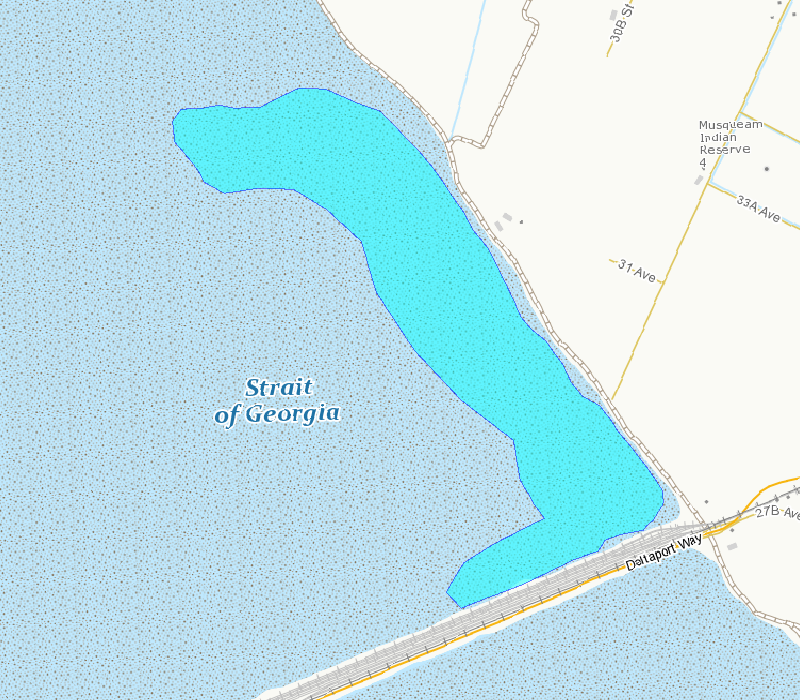1991
Type of resources
Topics
Keywords
Contact for the resource
Provided by
Years
Formats
Representation types
Update frequencies
status
-

This polygon outlines the basic area included in the survey counts. This area is the best approximation of the mudflat that can be surveyed from shore and is exposed at tide tide height of 3.5 m, based on tidal predictions at Point Atkinson, British Columbia.
-

This line outlines the basic survey route included in the survey counts. This route is the best access to areas that can be surveyed from shore.
-
These surveys focus on two abundant shorebird species, Western Sandpiper (Calidris mauri) and Dunlin (Calidris alpina), and are conducted at a large mudflat on Roberts Bank, Delta, British Columbia, approximately 35 km south of Vancouver. These survey counts began in 1991 and are conducted annually during the northern migration period (April and May). Species-specific counts are derived from total flock counts multiplied by an estimate of percentage composition of the two species. The Brunswick Point study site (49°03′ N, 123°09′ W) extends over the southern third of Roberts Bank, and encompasses a large mudflat (tidal range = 0 – 3.8 m) separated from agricultural fields by a dike. Vegetation in the near shore sections of the mudflat is composed mostly of saltmarsh and bushes. Sediments in the mudflat range from soft mud to sand, and portions of the lower intertidal zone are covered with eelgrass (Zostera marina and Z. japonica). A causeway supporting a major port facility separates the mudflat from the remainder of Roberts Bank, and the dike is used for recreational purposes. Total flock counts. The number of total flock counts conducted annually varied from seven to 15 counts from 1991 to 1998. Beginning in 1999, counts were conducted either daily or every other day during spring migration for an annual replicate of 17 32 counts. The migration period began on 15 April each year and continued until lesser than 1000 birds were observed or until 15 May, whichever came first. This timing was chosen to overlap with the major pulse of Western Sandpiper migration and also captured peak Dunlin numbers. Daily timing of surveys depended on the tide cycle; the start of surveys ranged between 05:45 and 19:00 hr. Counts were conducted at a tide height of 3.5 m, based on tidal predictions at Point Atkinson, British Columbia. This tide height ensured birds were close to shore, with sufficient mudflat exposed to present good feeding opportunities for shorebirds. Occasionally maximum daily tide heights did not reach 3.5 m, and counts on these days were conducted during the actual maximum tide heights. Counts began at the southern end of the Brunswick Point dike where it meets the Roberts Bank Superport causeway. All birds visible on the mudflat were counted from a vehicle along a series of stops on the dike, for a total length of ~2.5 km. Birds were counted through a spotting scope mounted on the vehicle window, primarily for distant flocks, and through binoculars to count birds near the vehicle. Flocks were counted by an initial assessment of flock density, and then by counting blocks incrementally in 50s, 100s, 500s, or 1000s, according to flock size, in each successive field of view across a scan of the entire flock. In 1992, the number of birds in large flocks was estimated by multiplying the number of square metres of mudflat covered by the flock by the average number of sandpipers in several 1-m2 plots estimated by eye (Butler 1994). Species composition: Only total flock counts were conducted prior to 1997, as deriving species-specific counts was complicated by the intermixing of Western Sandpipers and Dunlin in the large flocks. Species-specific counts are calculated as a product of total flock counts and percentage composition of different species. From 1997 onwards, relative species composition (ratio of Western Sandpipers to Dunlins) was estimated during supplementary counts as birds settled on the mudflats before or after the main shorebird counts described above. Numbers of Western Sandpipers and Dunlins were individually tallied along visually estimated 1 m wide strips that ran perpendicular from the dike to the water’s edge, and included both open mudflat and shallow water. Tallies of all strip counts were summed and the species proportion for that day was calculated as the number of each species counted divided by the total number of birds.
-
Predicted and actual counts of sandpipers utilizing the portion of Roberts Bank along “Brunswick dike” (the shoreline between the base of the Roberts Bank Coal Port causeway northwestwards to Brunswick Point at the mouth of Canoe Pass).
-

The Global Deterministic Prediction System (GDPS) is a coupled atmosphere (GEM), ocean and sea ice (NEMO-CICE) deterministic numerical weather prediction model. Forecasts are carried out twice a day for 10 days lead time. The geographical coverage is global on a native Yin-Yang grid at 15 km horizontal resolution. Data is available for 33 vertical levels and interpolated on a global latitude-longitude uniform grid with 0.2 degree horizontal resolution. Variables availability in number and time frequency is a function of forecast lead time.
